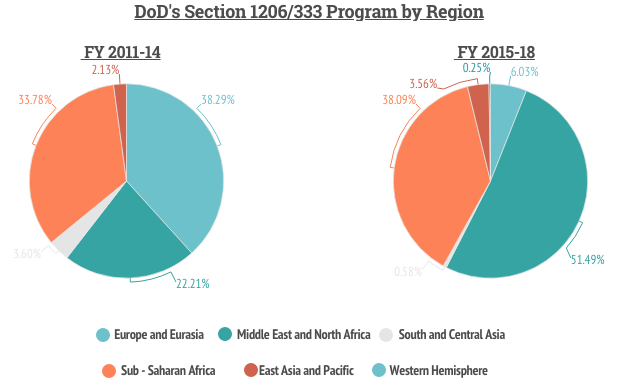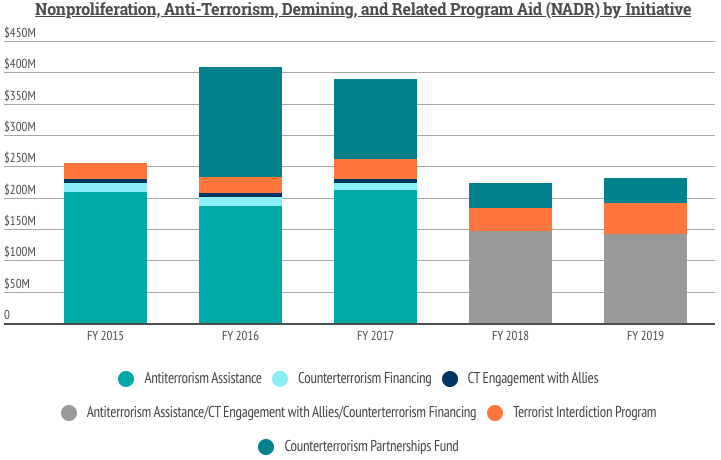Trump Admin. Continues Spike in Counterterrorism Aid to Africa
Trump Admin. Continues Spike in Counterterrorism Aid to Africa
U.S. Counterterrorism Aid Globally Increasingly Focused on
Foreign Militaries, Border Security, and Anti-Radicalization
Press Release, May 16, 2018
The Trump Administration is continuing an unprecedented increase in U.S. foreign aid to countries in Sub-Saharan Africa to address terrorist groups threats through the Defense and State Departments, according to a fact sheet released today by Security Assistance Monitor. The fact sheet highlights key new data on the Pentagon’s main global counterterrorism aid program (Section 1206/333). From FY 2015-18, the Defense Department notified the U.S. Congress of a total $954 million in counterterrorism aid to countries in Sub-Saharan Africa through these programs. This amount is nearly triple the amount for the previous four years.
Following the Obama Administration’s lead, the Trump Administration approved a total $244 million in counterterrorism aid for countries in Sub-Saharan Africa for FY 2017-18 through the Defense Department’s Section 333 program. The top ten recipients of this aid during this period for Africa are Uganda, Kenya, Chad, Cameroon, Burkina Faso, Mauritania, Nigeria, Niger, and Senegal. The majority of Section 1206/333 aid to African countries is focused on building foreign military capacity to engage in combat operations and improve their air support, logistics, and command and control efforts.

“As the United States becomes more engaged in combating terrorist groups in Africa both in terms of U.S. foreign aid and U.S. military operations (such as in Niger), it will need to invest more time into understanding the risk of these activities to mitigate the potential loss of U.S. weapons and soldier lives,” said Colby Goodman, Director of Security Assistance Monitor. “A key challenge in many of these countries is high levels of corruption within their defense sector.”
In connection with a Stimson Center study on U.S. government-wide counterterrorism spending released today, this fact sheet also provides a clearer picture of total U.S. counterterrorism aid globally and shows key new trends and gaps in U.S. transparency. In FY 2019, the Trump Administration proposed an estimated total of $11.2 billion for U.S. counterterrorism aid, which is slightly less than FY 2018. This number, however, could be higher or lower as the U.S. government does not systematically categorize counterterrorism aid data.
The biggest change between the Obama and Trump Administrations in global counterterrorism spending is the Trump Administration’s major cuts to the State Department. In FY 2019, the Trump Administration proposed a total $2 billion in U.S. counterterrorism aid through the State Department, which is a $1.3 billion decrease in aid compared to FY 2017 or FY 2016. One of the key cuts is a 38 percent drop in the State Department’s Anti-Terrorism Assistance Initiative, which focuses on supporting foreign law enforcement to address terrorism threats. The countries that saw the largest drop in this type of aid were Somalia, Libya, Yemen, Tunisia, and Jordan.
“The proposed cuts to State Department counterterrorism aid aimed at assisting foreign law enforcement sends a warning signal that the Trump Administration is favoring the military over the police in U.S. counterterrorism aid to foreign security forces,” said Christina Arabia, Program and Research Associate at Security Assistance Monitor. “By regularly engaging with the public, the police can provide a much better sense of terrorist threats and how to address them.”

At the same time, the Trump Administration has increased State Department funding to support foreign countries with terrorist interdiction at borders and in reducing terrorism recruitment or radicalization (or Countering Violent Extremism - CVE). Despite some Trump Administration early complaints about CVE, the administration proposed over $218 million for the initiative in FY 2018. The majority of the Trump Administration’s proposed CVE aid is focused on Sub-Saharan Africa and South and Central Asia for FY 2018-19.
This fact sheet also highlights the difficulty in determining U.S. counterterrorism aid globally and in some cases on a country level. This data and information is essential for the U.S. policy community to understand to help identify risks before the aid is given and to evaluate the aid after it is delivered. Yet, as the Stimson Center report highlights there are serious inconsistencies in how the U.S. government categorizes counterterrorism spending.
In some key ways, the Defense Department is improving its transparency on U.S. counterterrorism aid with more transparency on its Section 1206/333 data while the State Department’s data is decreasing in transparency. For instance, the State Department leaves out critical details on proposed country level spending through its Peacekeeping Operations program that are included for other programs. Under the Trump Administration, the State Department has also stopped identifying how much aid is going to its Counterterrorism Financing initiative.
For more information and for interviews, please contact Colby Goodman at Colby@ciponline.org or 202-232-3317 ext. 113 or Christina Arabia at Christina@ciponline.org or 202-232-3317 ext. 112.
